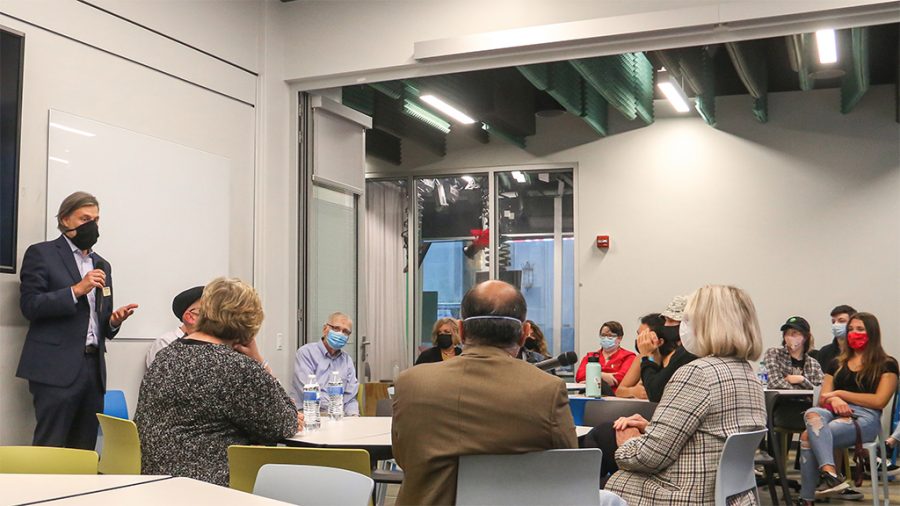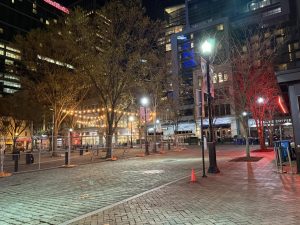Center for Media Innovation hosts 9/11 20th anniversary commemoration
Photo by Aidan Ringiewicz
CMI Director Andy Conte in front of panelists Tom McMillian, Deb Erdley, Cindi Lash and Ramesh Santanam.
September 15, 2021
On Sept. 8, 2021, Point Park University’s Center for Media Innovation (CMI) hosted a free, in-person event in commemoration of the 20th anniversary of 9/11.
Four journalists from the Pennsylvania region were welcomed to the CMI to tell their stories about their coverage of Flight 93 that crashed in Shanksville, Pennsylvania on September 11, 2001 and their experiences on that day.
“Flight 93, in particular, is still known as the forgotten flight,” Tom McMillian, Author of “Flight 93: The Story, The Aftermath and The Legacy of American Courage on 9/11” said. “The Pittsburgh media outlets are the ones who really covered this story and got it more international coverage.”
NPR reported that the flight departed from Newark International Airport (later renamed Liberty International Airport) at 8:42 a.m. with 40 passengers and crew members on board as well as the 4 hijackers, after being more than 40 minutes late from its original departure time of 8 a.m.
“The first plane hit the first tower at 8:46 a.m., the second plane hit at 9:03 a.m., now there is massive coverage on all the networks,” McMillian said. “By the time Flight 93 was in the air, it’s 9:30 a.m., the passengers’ loved ones had already been watching television for a half an hour.”
According to the Flight 93 National Memorial webpage, the reason behind the Flight 93 hijacking was to stray attention away from the planned destination, the nation’s capital.
The 9/11 Commission Report, which was available on Flight 93’s website, stated at 9:55 a.m., hijacker Ziad Jarrah had dialed in the frequency for aid at Washington Reagan National Airport. This indicated that the destination of the flight was most likely the nation’s capital, since the flight’s initial path was to land in San Francisco, California.
Deb Erdley, journalist for the Trib Total Media, recounts the day that led to her team seeing the crash site on Sept. 11.
“I saw the first and second planes hit on the news, then the Pentagon,” Erdley said. “Suddenly, we got a call from one of our photographers who happened to be in Latrobe and tracked Flight 93, heard the crash, and located the site of the crash. One of our senior writers looked around the room and sent me and a few of my colleagues up to Shanksville. By the time we made it there, the site was already off limits.”
After the hijackers took control of the flight, passengers and crew made the decision to intervene.
According to NBC News, the cockpit recordings that were extracted from the plane after the crash detailed how the counterattack brought fear amongst the hijackers. The reports from the 9/11 commission said that the hijackers feared the passengers would take control of the plane, causing the hijackers to abort their original plan and leading the aircraft to crash in Shanksville.
“I remember going up to the crash site later that afternoon, a scheduled bus trip took reporters up to the site,” Cindi Lash, Executive Editor of Pittsburgh Community Broadcasting Corporation, said. “There was some smoke, but one of the visceral things I remember was how bad it smelled. The jet fuel stunk. You then saw an arrow shaped divot in the ground, but it didn’t look like anything that should have been a plane. It was a visually shocking thing.”
Nine days after investigations had begun on the attacks on the World Trade Center, the Pentagon, and Flight 93, then-president George W. Bush issued a statement.
“The enemy of America is not our many Muslim friends,” Bush said. “It is not our many Arab friends. Our enemy is a radical network of terrorists and every government that supports them.”
The effects of these events, according to PBS NewsHour, instituted impacts on immediate responses out of concerns for safety, air travel, the structure of future buildings, and the handelings of immigration and deportation.
Freelance journalist and former Associated Press and Valley News Dispatch writer Ramesh Santanam explained how the impacts of 9/11 affected the views of those around him, and what his personal experiences were like on that fateful day.
“I had been working on an assignment for the Valley News Dispatch in Tusan, Arizona at the time of the crashes,” Santanam said. “That afternoon, I went to the university hall where I was getting my documents from and saw President Bush on the TV. He was saying, ‘don’t retaliate against those who don’t look like us.’ I looked around and realized, wow, I’m one of those people now.”
Santanam later recalled his fear of traveling back home after the initial attacks.
“I remember walking onto the plane to go home and having people looking at me and for the first time in a long time, I became self-conscious of how I looked just because I looked different from everyone else. I worried about my safety.”
Despite these events, in some ways America came together like never before. As stated by the HuffPost, people across the country collectively sent support to the victims of the attacks and their loved ones.
“It was a time when everyone was an American,” Erdley said. “There was no red America, there was no blue America. It was a different time.”
The commemoration of the 20th anniversary of 9/11 at the Center for Media Innovation can be viewed on Point Park University’s Center for Media Innovation Facebook page.


















